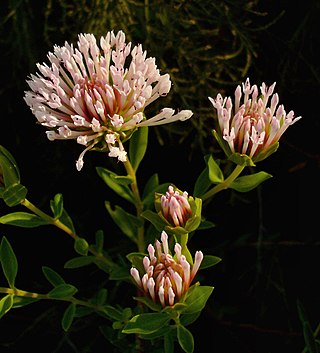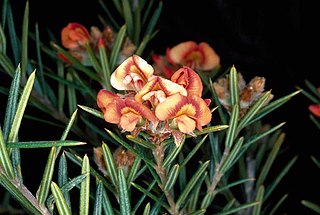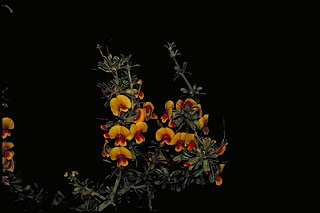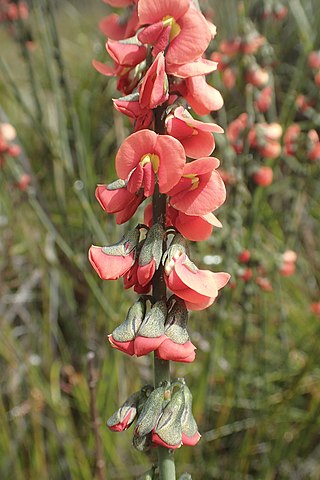
Mirbelia is a plant genus belonging to the family Fabaceae and is endemic to Australia, occurring in every mainland state except South Australia. Plants in the genus Mirbelia are prickly, perennial shrubs with simple, sometimes sharply-pointed leaves, or the leaves absent. The flowers are arranged singly or in groups in leaf axils or on the ends of branches, the sepals joined at the base with five teeth. The petals are usually red, orange, purplish or bluish and the fruit is an inflated pod.

Pimelea calcicola is a species of flowering plant in the family Thymelaeaceae and is endemic to part of the west coast of Western Australia. It is an erect to spreading shrub with elliptic leaves arranged in opposite pairs, and head-like racemes of pale to deep pink, tube-shaped flowers surrounded by leaf-like involucral bracts.
Eremophila ferricola is a flowering plant in the figwort family, Scrophulariaceae and is endemic to Western Australia. It is an erect shrub with lance-shaped leaves and yellowish brown to greenish yellow flowers covered with fine hairs. The species is only known from a single location, growing on a banded ironstone hill.
Gompholobium karijini is a species of flowering plant in the family Fabaceae and is endemic to the north-west of Western Australia. It is an erect, openly-branched shrub with pinnate leaves with five to ten pairs of leaflets, and racemes of yellow to orange and creamy-yellow, pea-like flowers.
Bossiaea peduncularis is a species of flowering plant in the family Fabaceae and is endemic to Western Australia. It is an erect, more or less leafless shrub with arching branches, cladodes ending with a point and deep yellow, red and greenish-yellow flowers.
Gompholobium oreophilum is a species of flowering plant in the family Fabaceae and is endemic to the north-west of Western Australia. It is an erect shrub with pinnate leaves with elliptic leaflets, and racemes of yellow to orange and creamy-yellow, pea-like flowers.
Gompholobium polyzygum is a species of flowering plant in the family Fabaceae and is endemic to north-western Australia. It is an erect or prostrate shrub with pinnate leaves each with sixteen to twenty-one pairs of leaflets, and yellow-orange and greenish, pea-like flowers.
Bossiaea zarae, commonly known as Princess May winged pea, is a species of flowering plant in the pea family Fabaceae and is endemic to the northern Kimberley region of Western Australia. It is an erect shrub with winged stems, winged cladodes, scale-like leaves and yellow, and reddish-brown flowers.
Daviesia eremaea is a species of flowering plant in the family Fabaceae and is endemic to central Australia. It is an erect, glabrous, multi-stemmed shrub with needle-like, more or less sharply-pointed phyllodes, and yellow and red flowers.
Sphaerolobium benetectum is a species of flowering plant in the family Fabaceae and is endemic to the south-west of Western Australia. It is tuft-forming sub-shrub with erect stems, linear to lance-shaped leaves, and yellow-orange and pink to red flowers.
Mirbelia balsiformis is a species of flowering plant in the family Fabaceae and is endemic to the far west of Western Australia. It is an erect to sprawling shrub with leaves reduced to triangular scales, and yellow to orange and red flowers arranged in racemes on the side of the branchlets.

Mirbelia confertiflora is a species of flowering plant in the family Fabaceae and is endemic to eastern Australia. It is a rigid, bushy shrub with linear leaves and yellow to orange flowers arranged in racemes near the end of the branches.
Mirbelia corallina is a species of flowering plant in the family Fabaceae and is endemic to the far west of Western Australia. It is a slender, sprawling sub-shrub with a few narrowly elliptic to narrowly egg-shaped leaves and pink and yellow flowers arranged in racemes near the ends of the branchlets.

Mirbelia granitica is a species of flowering plant in the family Fabaceae and is endemic to inland areas of Western Australia. It is an erect or spreading shrub with spiny branches, scattered linear to narrowly egg-shaped leaves and yellow and red flowers.
Sphaerolobium pubescens is a species of flowering plant in the family Fabaceae and is endemic to the south of Western Australia. It is a small shrub or subshrub with slender stems, tapering linear leaves and dense racemes of yellow flowers.

Sphaerolobium rostratum is a species of flowering plant in the family Fabaceae and is endemic to the south of Western Australia. It is an erect to sprawling shrub or subshrub with slender stems, tapering linear leaves and loose racemes of pink and cream-coloured flowers.

Mirbelia ramulosa is a species of flowering plant in the family Fabaceae and is endemic to the south-west of Western Australia. It is an erect, much-branched, spiny, leafless shrub with yellow and red, purple or brown flowers.
Mirbelia rhagodioides is a species of flowering plant in the family Fabaceae and is endemic to inland areas of Western Australia. It is an erect, prickly shrub with clustered linear or narrowly elliptic leaves and yellow and red flowers.
Mirbelia stipitata is a species of flowering plant in the family Fabaceae and is endemic to inland areas of Western Australia. It is a spiny, more or less leafless shrub with yellow and red flowers.
Thomasia × formosa is a species of flowering plant in the family Malvaceae and is endemic to a restricted area of the south-west of Western Australia. It is an erect, compact shrub with densely hairy branchlets, hairy, coarsely serrated, egg-shaped to elliptic or oblong leaves, and racemes of pink or purple flowers arranged in leaf axils.





